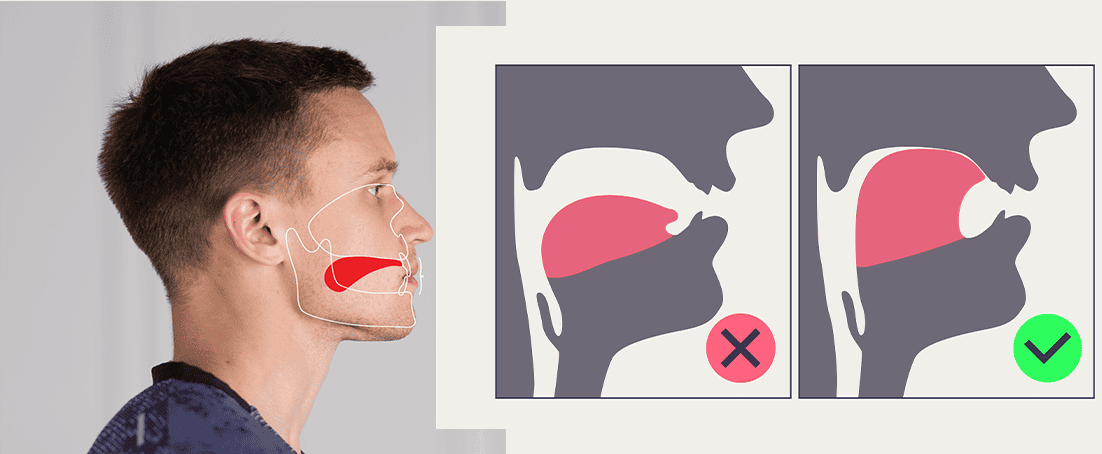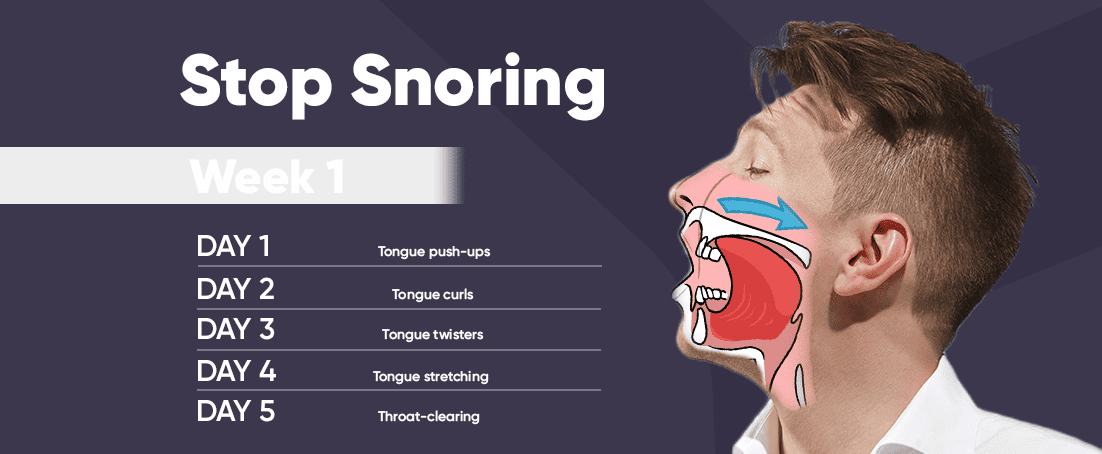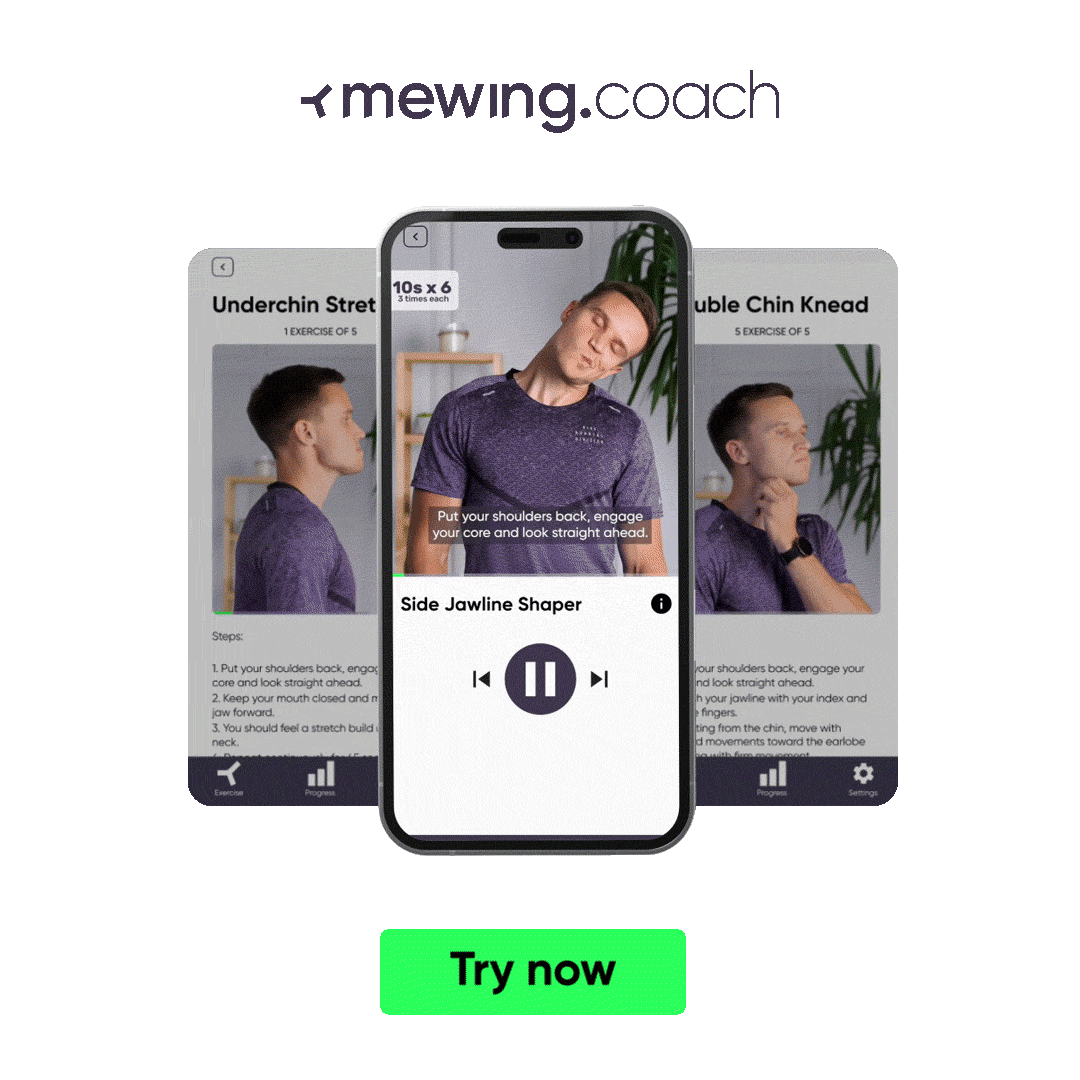
Did you know that doing tongue-strengthening exercises can increase brain stimulation and can help with reducing those overwhelming thoughts? Tongue exercises are a training technique for promoting appropriate tongue mobility, that provides a range of benefits which we will explain further in the text. By improving the range of motion of the tongue muscle you can achieve speech clarity, reduce snoring and much more in only a few weeks.
But many people are skeptical about it. So, do tongue and swallowing exercises work?
Here’s what we’ll talk about in this article:
📄 What are the best tongue-strengthening exercises?
📄 What are the benefits of a tongue exercise?
📄 Can you reduce snoring?
📄 Can you deal with sleep apnea?
Read more to find out!
Benefits of tongue exercises
Training your tongue regularly can help with general focus retention and improved brain capacity. Your mind will be clear, and fully focused and you’ll notice advantages in your farsightedness, well-being, digestion, and resistance to the flu and cold. In addition, you’ll gain strength and agility. Some research even shows that tongue strengthening and swallowing exercises may reduce the risk of Alzheimer’s.
Also, for all those that struggle with snoring, tongue stretches can help tone the muscles in the airway area, and make the snoring less frequent or loud. The benefits do not stop there; tongue exercises can alleviate sleep apnea, teeth grinding, tiredness, mumbling or stuttering, and improve sleep quality and oral health. Additionally, it can improve your facial features by strengthening your jawline and reducing your double chin and boosting overall health.
All these exercises are combined in Mewing, which you can get by incorporating this simple method into your everyday life. And to further prove it, there’s a long comprehensive list of mewing advantages you can check out.
Tongue Strengthening Exercises
The tongue is an organ, separated into two portions, and made up of a sophisticated configuration of intrinsic and extrinsic muscles. The extrinsic muscles are in charge of moving the tongue in various directions, whereas the intrinsic typically affect the form of the tongue. The tongue has a significant role in breathing, in addition to being primarily involved in digestion, taste perception, and communication through speech.
The question is, can you increase tongue strength and work closely to unlock all the benefits of practicing tongue-strengthening exercises? And the answer is – Yes! All you have to do to fix your lazy tongue is include a few simple, fast, and common tongue-strengthening exercises in your daily routine.
Before you start – it is important to note that while doing these specific exercises you should move your tongue as far as you are comfortable. You are not supposed to feel any pain, just a nice and firm stretch in the muscles. Food and drinks should be consumed while exercising. The best results can be seen if these tongue-strengthening exercises are performed consistently.
1. Tongue push-ups

While pushing up with your tongue out as far as possible, push down with a tongue depressor. Hold for 5 seconds and repeat the exercise 5 times daily. This tongue-strengthening exercise is a good addition to the other swallowing exercises and will help you with your swallowing muscles.
2. Tongue curls

Stick your tongue out to the bumpy area at the top of your mouth, just behind your teeth. Then curl the tongue back into your mouth as further as possible. You need to hold this position for a few seconds and repeat it at least 5 times.
3. Tongue twisters
This one is fun! Tongue twisters are amazing in helping out with improving your pronunciation and fluency. Tongue twister excesses are not for children only, they are used frequently by politicians, actors, public speakers and all those who wish to improve their tongue and speech. Here are a few examples:
- Selfish shellfish. (Repeat several times)
- Near an ear, a nearer ear, a nearly eerie ear.
- A happy hippo hopped and hiccupped.
- A synonym for cinnamon is a cinnamon synonym.
- He threw three free throws.
- Fred fed Ted bread and Ted fed Fred bread.
Repeat quickly the tongue twister several times in a row, to make it more fun and challenging.
4. Mewing

Mewing is a special practice for proper tongue posture. There is an extensive list of benefits of making mewing a habit, starting with the improvement of facial symmetry, straightening of the jawline, and reducing the double chin, but mewing exercises are also used as tongue strengthening exercises and swallowing exercises to regenerate those tongue muscle and restore your tongue naturally. It will also help you to learn proper swallowing practices with different swallowing exercises.
To start off, relax and close down your lips gently, and make sure your teeth are in contact. Then, press your tongue against the roof of your mouth. Repeat 5 times.
Learn everything about mewing to properly treat lip position, tongue, chewing, and body positions, and you can even get an amazing Mewing.coach app to guide you in the battle of losing your double chin, improving your tongue strength, reducing snoring, and much more. Practicing mewing daily can really change your everyday life.
Tongue Exercises for a Longer Tongue
Many of us, don’t think of our tongues as something that should be exercised. However, the tongue is a very important organ built out of muscles. Your oral health, voice quality and fluency may suffer as a result. It could also affect how you eat. That is why tongue stretches exercises to lengthen the tongue are very important. Here are some examples:

Tongue stretching
Stretch your tongue upwards and hold for 10 seconds. You should repeat that 10 times.
With the tongue stretches you will enlengthen your tongue and improve your tongue mobility. The mowing practices also include many exercises to stretch your tongue, and if you are wondering how mewing corrects your tongue posture, you should definitely start practicing mewing right away.
Tongue extension
Start by sticking out your tongue further as possible to give it a nice stretch. Hold it steady for at least 5 seconds, then relax and repeat 5 times.
Throat and Tongue Exercises to Stop Snoring
We all know how tiring and uncomfortable snoring can be. But you should not worry anymore. Tongue and throat exercises can help alleviate snoring, improve sleep apnea condition and fix your facial posture and physical appetence at the same time. What you need to do is to spend only a few minutes every day and follow these exercises to improve your throat and tongue muscle tone. Some orthodontists even prescribe tongue-strengthening exercises.

Uvular trills
To perform an Uvular trill, you need to press the tongue’s back against the uvula and try to move some air to make the uvula vibrate on its own. It’s like making a cat purr sound.
Soft palate exercises
Use air to puff your cheeks out; Keep inhaling and exhaling through your nose. Put a finger on your puffy cheeks and push. Keep your lips firmly closed at all times. Avoid letting air escape through your nose or mouth.
Throat-clearing exercises
Hold a long, deep breath. While you swallow, keep holding your breath. Cough immediately after swallowing (The supraglottic swallow). Repeat this exercise several times.
Take a deep sigh. As you descend, continue to hold your breath. Relax after a few seconds of holding your breath. Repeat this exercise several times.
Throat and tongue-strengthening exercises are an addition to swallowing exercises and can help you restore your tongue naturally. In addition, if you have a lazy tongue-a condition when the muscles that are used for speech are weak, or if you have difficulty controlling them, this is good news for you. The weak tongue muscles can be caused by nervous system disorders and conditions, or some medications. If you are wondering how to get your tongue back to normal or how to relax your tongue, continue reading.
Tongue Tension Exercises
Everyday stress and constant pressure on the jaw and tongue can accumulate a lot of tongue tension! This can affect your speech, cause oral health issues, or intrude on your ability to swallow. Whether you are just tired and stressed, or have a tongue-tie condition, these exercises to relieve tongue tension will give you the key to dealing with tongue muscle weakness.
Tongue relaxation exercises
Hold your tongue completely still and keep the tip of your tongue in the back of your bottom teeth for 20 seconds. Repeat 3 times.
Having no pressure in your jaw area is immensely important. Many people are dealing with ankyloglossia, or tongue-tie, a condition that prevents the tongue from moving freely, and obstructs all daily movement requirements. There are other nervous system conditions that can cause the same symptoms. However, the mewing practices are completely adaptable, and if you are wondering how to mew with a tongue tie condition to improve tongue mobility and strength, you can find much information online and there are apps to guide you through swallowing exercises and other exercises.
Tongue massage
Take a small and clean towel. Stretch your tongue as far as you can and then gently massage it over the towel.
Tension in the tongue can be relieved with massage. The pressure and touch of your fingers on your tongue can tell you where tension is still present, and where potential problems might be. Your tongue is not functioning properly if it hurts to touch or press on it. The pain goes away when you massage it, breathe into it, and let go of the tension there.
Conclusion
After reading this, you are already aware of how to retain your tongue using the methods listed above, and make your life better by reducing snoring, teeth grinding, obstructive sleep apnea, and tiredness, improving sleep quality and oral health, better your facial features by strengthening your jawline and reducing your double chin. Here is an extra tip for you… take vitamin B complex, it’s very good for your tongue.
If you are also interested in what is a tongue chewing method and how can you break off that tongue tension even more, you should definitely include it alongside mewing in your daily routine. A lot of people have given helpful feedback, and have seen the most benefits when sticking to exercising consistently. Don’t lose any more time, practice these exercises, and take charge of the quality of your life.




